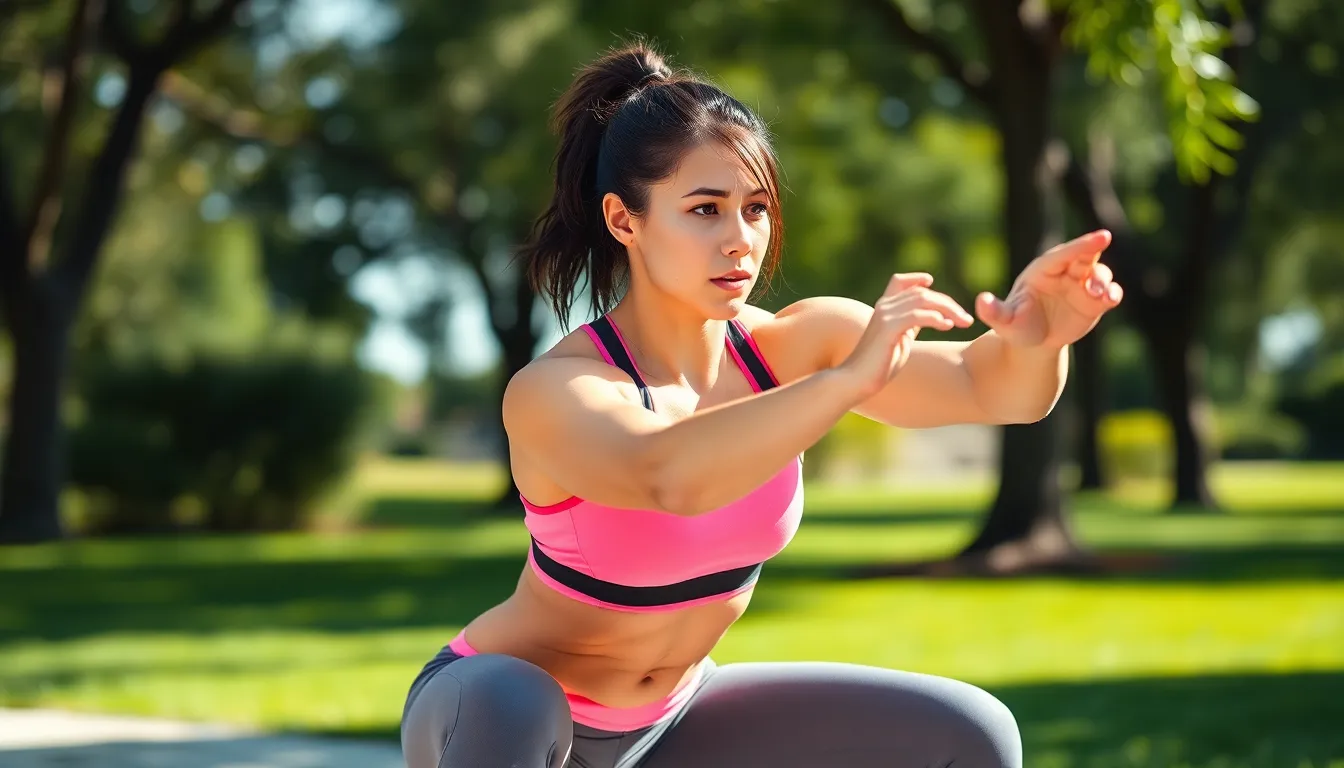In a world where gym memberships and fancy equipment often dominate fitness routines, bodyweight exercises stand out as a powerful alternative. These exercises harness the weight of one’s own body, making them accessible to anyone, anywhere. Whether in a living room, park, or hotel room, individuals can build strength, flexibility, and endurance without any special gear.
Bodyweight exercises offer a versatile approach to fitness that suits all levels. From push-ups and squats to planks and lunges, they can be easily modified to match personal goals. This flexibility not only keeps workouts fresh but also encourages consistency, which is key to achieving lasting results. Embracing bodyweight training can lead to a healthier lifestyle while fostering a sense of empowerment and independence in one’s fitness journey.
Table of Contents
ToggleOverview of Bodyweight Exercises
Bodyweight exercises rely on an individual’s weight for resistance, removing the need for external equipment. These exercises enhance strength, flexibility, balance, and endurance. Variations of bodyweight moves exist to suit different fitness levels, making them accessible to beginners and experienced athletes alike.
Common bodyweight exercises include:
- Push-ups: Target the chest, shoulders, and triceps while engaging the core.
- Squats: Strengthen the legs and glutes, incorporating stability and mobility.
- Planks: Work the core, shoulders, and back, promoting overall stability and strength.
- Lunges: Focus on leg strength, balance, and flexibility, with options for forward, reverse, or side movements.
Bodyweight exercises offer a variety of benefits, including improved functional fitness, increased muscle endurance, and enhanced cardiovascular health. They can be performed anywhere, requiring no more than a flat surface, allowing individuals to incorporate fitness into daily routines. Plus, their adaptability promotes creative workout structures, enabling individuals to set personal goals and track progress effectively.
Benefits of Bodyweight Exercises

Bodyweight exercises offer numerous advantages that cater to various fitness needs. These exercises improve strength, endurance, flexibility, and balance, providing a comprehensive approach to fitness without special equipment.
Improved Strength and Endurance
Bodyweight exercises enhance muscular strength and endurance effectively. Movements like push-ups, squats, and lunges engage multiple muscle groups simultaneously. Each repetition builds muscle fibers and increases overall strength. For instance, performing three sets of 10 push-ups not only strengthens the chest, shoulders, and triceps but also improves core stability. Additionally, bodyweight training promotes endurance through high-rep workouts, allowing individuals to sustain activity levels for longer periods.
Enhanced Flexibility and Balance
Bodyweight exercises contribute significantly to flexibility and balance. Exercises such as lunges and planks stretch and strengthen key muscle groups, promoting a full range of motion. For example, including dynamic stretches, like leg swings, before workouts enhances joint flexibility and prepares muscles for movement. Moreover, stability-focused exercises, like single-leg squats, improve balance by engaging stabilizing muscles. This increased flexibility and balance aids in injury prevention and enhances overall athletic performance.
Types of Bodyweight Exercises
Various types of bodyweight exercises target different muscle groups, providing a comprehensive workout. These exercises can be categorized into upper body, lower body, and core exercises, each designed to enhance strength, flexibility, and balance.
Upper Body Exercises
Upper body exercises focus on the muscles of the chest, back, shoulders, and arms. Common variations include:
- Push-Ups: Engage the chest, shoulders, triceps, and core. Variations such as decline or diamond push-ups can increase difficulty.
- Dips: Target the triceps and chest. Performing dips on parallel bars or a sturdy surface adds intensity.
- Plank to Push-Up: Builds stability and strength in the arms, shoulders, and core while promoting proper form through transitions.
- Inverted Rows: Utilize a bar or surface to work the back and biceps while improving grip strength.
Lower Body Exercises
Lower body exercises strengthen the legs, glutes, and hips. Notable options include:
- Squats: Activate the quadriceps, hamstrings, and glutes. Variants like jump squats or pistol squats enhance intensity and balance.
- Lunges: Target the thighs and glutes, with variations such as forward, backward, and lateral lunges to diversify muscle engagement.
- Step-Ups: Require stepping onto an elevated surface, working the quads and glutes while improving stability.
- Calf Raises: Strengthen the calves and improve ankle stability, beneficial for overall leg strength.
Core Exercises
- Planks: Engage the entire core, including deep stabilizing muscles, with variations like side plank and plank with shoulder taps for added difficulty.
- Mountain Climbers: Combine core and cardiovascular training, engaging the abs, shoulders, and legs in a dynamic movement.
- Bicycle Crunches: Target the obliques and rectus abdominis, enhancing coordination and core strength.
- Leg Raises: Focus on the lower abdominal muscles, promoting flexibility in the hip flexors while challenging core stability.
How to Create a Bodyweight Exercise Routine
Creating a bodyweight exercise routine involves assessing individual fitness levels and structuring workouts effectively. Developing a personalized approach ensures optimal results and sustainability.
Assessing Your Fitness Level
Assess fitness by evaluating personal strengths and limitations. Perform a series of exercises, such as push-ups, squats, and planks, to gauge endurance and strength. Count repetitions possible in one minute for exercises like push-ups and squats to determine baseline fitness. Identify any areas needing improvement, focusing on flexibility and balance. Understanding these factors aids in selecting appropriate exercises and modifications tailored to individual needs.
Structuring Your Workout
Structure workouts to balance intensity, duration, and recovery. Incorporate a warm-up of 5-10 minutes to prepare the body, using dynamic stretches or light cardio. Design circuits that target different muscle groups to ensure full-body engagement. For example, alternate exercises between upper body, lower body, and core. Aim for 20-30 minutes of high-intensity intervals followed by short breaks. Conclude with a cool-down to facilitate recovery, including static stretches to enhance flexibility and prevent soreness.
Tips for Maximizing Results
Maximizing results from bodyweight exercises depends on proper technique and increasing intensity. These strategies enhance performance and ensure safety during workouts.
Proper Form and Technique
Maintaining proper form and technique is essential when performing bodyweight exercises. Focusing on alignment prevents injuries and promotes muscle engagement. Notable aspects to consider include:
- Alignment: Keep the body in a straight line during push-ups and planks to engage core muscles effectively.
- Controlled Movements: Perform exercises slowly and deliberately to maximize muscle activation and minimize strain.
- Breathing: Coordinate breathing with movements; exhale during exertion and inhale during recovery to maintain endurance.
- Range of Motion: Utilize full range of motion in exercises like squats and lunges for optimal muscle engagement and flexibility.
Increasing Intensity
Increasing intensity can enhance strength and endurance while promoting better results. Strategies to elevate workout challenges involve:
- Elevating Body Position: Place feet on a raised surface during push-ups to target the upper chest and shoulders more effectively.
- Incorporating Variations: Add variations, such as single-leg squats or explosive push-ups, to engage different muscle groups and increase difficulty.
- Shortening Rest Periods: Minimize rest between sets to keep the heart rate elevated and build cardiovascular endurance.
- Utilizing Tempo Changes: Adjust tempo by slowing down during the eccentric phase of exercises, enhancing muscle tension and endurance.
Adopting proper form and increasing intensity will lead to more effective bodyweight workouts.
Bodyweight exercises offer a practical and effective way to achieve fitness goals without the need for a gym or equipment. Their adaptability makes them suitable for anyone regardless of fitness level. By incorporating a variety of movements targeting different muscle groups individuals can enhance strength flexibility and endurance.
With the ability to modify exercises and create personalized routines it’s easy to stay consistent and motivated. Prioritizing proper technique ensures safety and maximizes results. Embracing bodyweight training not only fosters physical health but also empowers individuals to take control of their fitness journey. This approach can lead to lasting improvements and a more active lifestyle.









